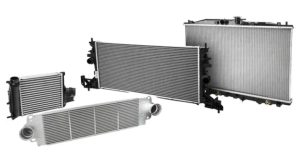High-performance engines generate extreme amounts of heat, especially turbocharged and supercharged systems. To keep temperatures under control, modern vehicles rely on multiple cooling components that work in harmony. The two most important parts of this system are radiators and intercoolers. While each performs a unique function, together they provide a comprehensive thermal management solution that boosts power, prevents engine knock, and protects vital components from overheating.
This article explains how these systems work, why they depend on each other, and how upgrading them can significantly improve engine performance. For high-quality components, you can Buy Radiator & Components online.
Radiator vs. Intercooler — What’s the Difference?

Although both cool air or fluid, radiators and intercoolers serve different purposes inside a vehicle.
Radiator Function
The radiator removes heat from the engine coolant and transfers it to the surrounding air. This prevents the engine block and cylinder head from overheating.
Intercooler Function
An intercooler cools the compressed air coming from a turbocharger or supercharger. Cooler air is denser, meaning more oxygen reaches the engine, which increases power and reduces the risk of detonation.
How They Work Together
Radiators deal with engine coolant temperature, while intercoolers handle intake air temperature. When both systems operate efficiently, the engine benefits from:
-
Lower combustion temperatures
-
Reduced thermal stress
-
Improved combustion efficiency
-
Higher power output
-
Stable performance during sustained acceleration
They form a two-step cooling chain:
-
Intercooler lowers intake air temperature → Engine produces cleaner, more powerful combustion.
-
Radiator removes heat generated from combustion → Engine maintains safe operating temperatures.
The result is a more efficient, powerful, and reliable engine.
Cooling Process Breakdown
Below is a simplified overview of how the two systems interact:
| Component | What It Cools | How It Helps the Engine | Typical Location |
|---|---|---|---|
| Radiator | Coolant | Prevents overheating, protects engine block | Front of engine bay |
| Air-to-Air Intercooler | Compressed intake air | Increases air density, reduces knock | Front bumper opening |
| Air-to-Water Intercooler | Intake air using coolant | Provides consistent cooling under heavy load | Near intake manifold |
Together, they maintain stable operating temperatures even in high-performance or heavy-load conditions.
What Happens If One Component Is Inefficient?
If the Radiator Underperforms:
-
Coolant overheats
-
Engine reaches dangerous temperature levels
-
Turbo systems receive excessive heat
-
Reduced performance and risk of head gasket failure
If the Intercooler Underperforms:
-
Intake air temperature rises
-
Air becomes less dense
-
Power loss (“heat soak”)
-
Higher risk of pre-ignition or detonation
Since both systems affect each other, poor performance in one can compromise the entire cooling cycle.
Benefits of Upgrading Radiators and Intercoolers Together
Performance vehicles, tuned engines, and turbocharged motors benefit significantly from upgraded cooling systems.
Key Advantages
-
Higher power output thanks to cooler, denser air
-
Reduced turbo lag
-
Improved coolant capacity and flow
-
Better reliability under repeated high-load driving
-
Lower risk of heat soak
-
Longer engine lifespan
Many enthusiasts upgrade both components at once to achieve optimal gains.
Types of Intercoolers and Radiators to Consider
Intercooler Types
-
Air-to-air intercoolers
Lightweight and effective at highway speeds. -
Air-to-water intercoolers
Offer stable cooling, ideal for performance or racing.
Radiator Types
-
OEM-style radiators
Standard cooling for everyday use. -
Two-row and three-row aluminum radiators
Increased coolant volume and surface area. -
High-density fin radiators
Maximum heat transfer efficiency.
Which Vehicles Benefit Most?
Some vehicles experience particularly high thermal stress and benefit from upgrading both the intercooler and radiator:
-
Turbocharged engines
-
Supercharged engines
-
Tuning or remapping applications
-
Towing or hauling vehicles
-
High-performance sports cars
-
Off-road and rally vehicles
Signs Your Cooling System Needs an Upgrade
If you notice any of the following issues, it may be time to consider better cooling components:
-
Rising coolant temperatures
-
Power loss during long acceleration
-
Turbo lag increasing under heat
-
Coolant boiling or expansion tank overflow
-
Frequent overheating
-
Intake air temperature spikes
-
Radiator or intercooler leaks
Ignoring these symptoms can lead to expensive engine repairs.
Comparison Table: Radiators vs. Intercoolers
| Feature | Radiator | Intercooler |
|---|---|---|
| Cools | Engine coolant | Compressed air |
| Primary Benefit | Prevents overheating | Improves power and efficiency |
| Affects Turbo System | Indirectly | Directly |
| Vulnerable to Heat Soak | No | Yes (air-to-air types) |
| Upgrade Benefit | Better heat management | Higher horsepower |
Where to Buy Quality Cooling Components

A high-performance cooling system begins with reliable components. You can explore top options and Buy Radiator & Components online for your vehicle.
Conclusion
The radiator and intercooler play different but equally important roles in maintaining optimal engine performance. Together, they ensure that both the engine coolant and intake air remain at safe temperatures, resulting in more efficient combustion, improved power, and long-term reliability.
Upgrading these components — especially on turbocharged or heavily used engines — can dramatically enhance performance, reduce heat-related wear, and extend engine life. Whether you are optimizing for power, safety, or durability, a well-designed cooling system is essential for maintaining the health of any high-performance engine.